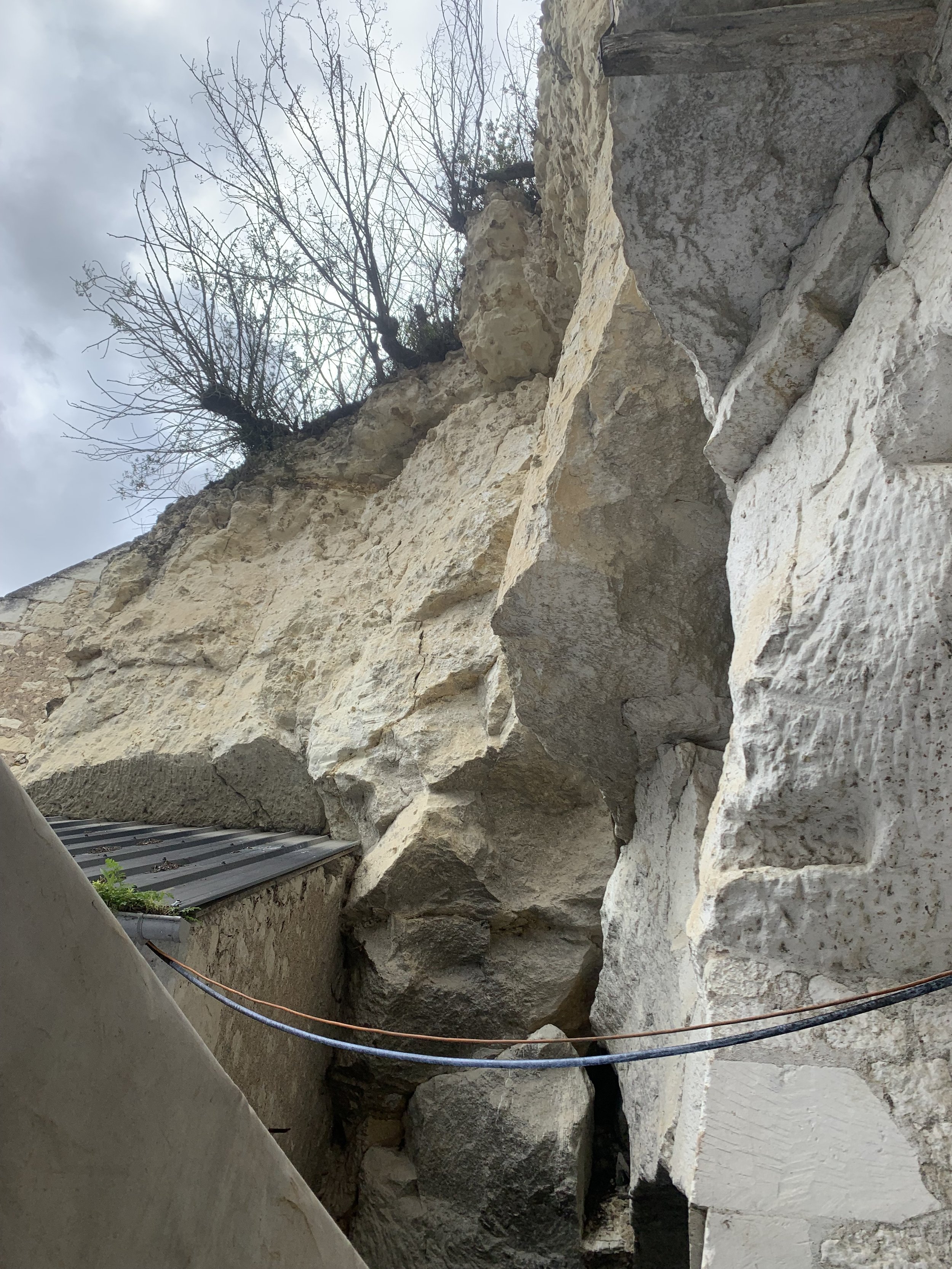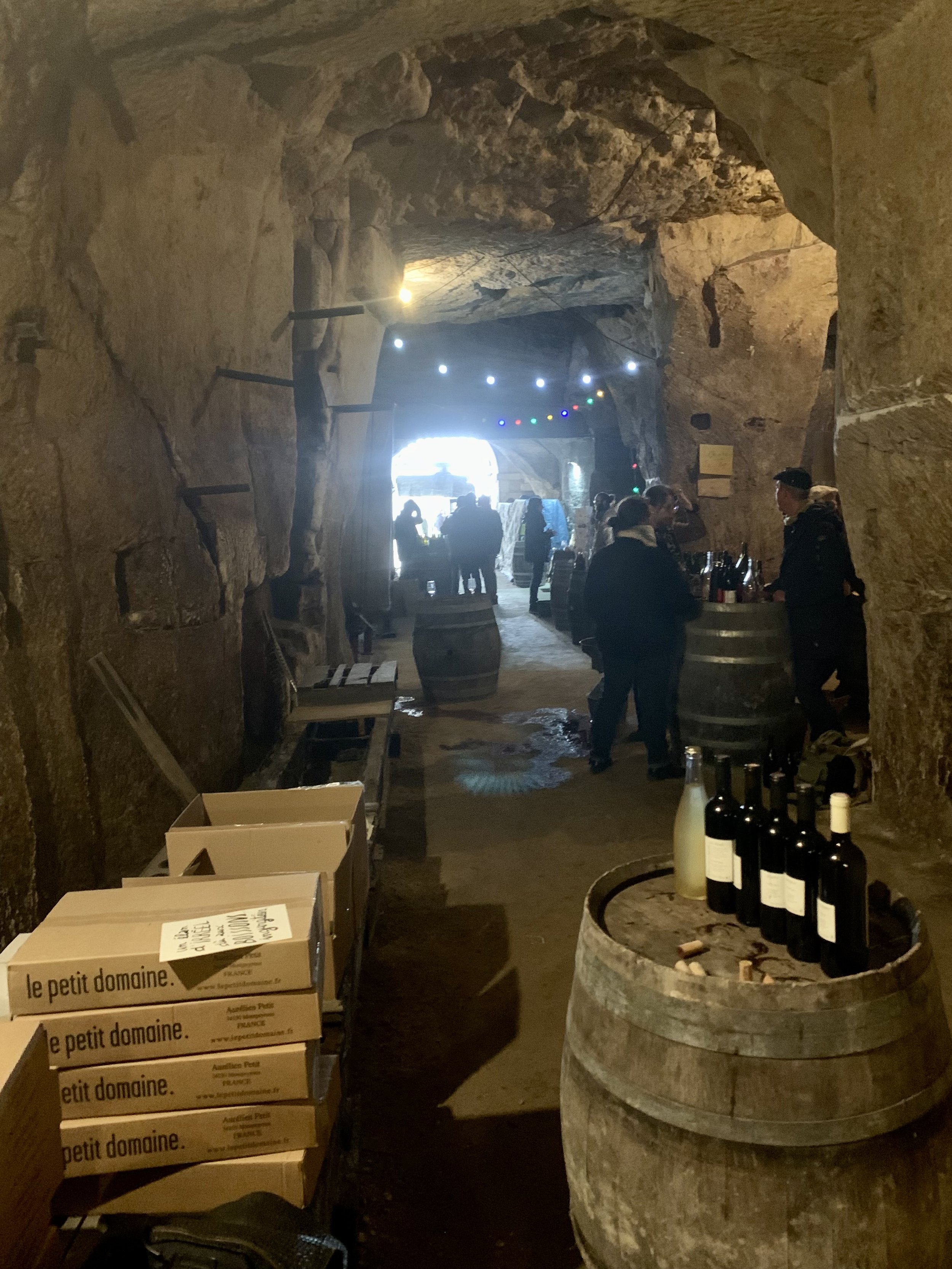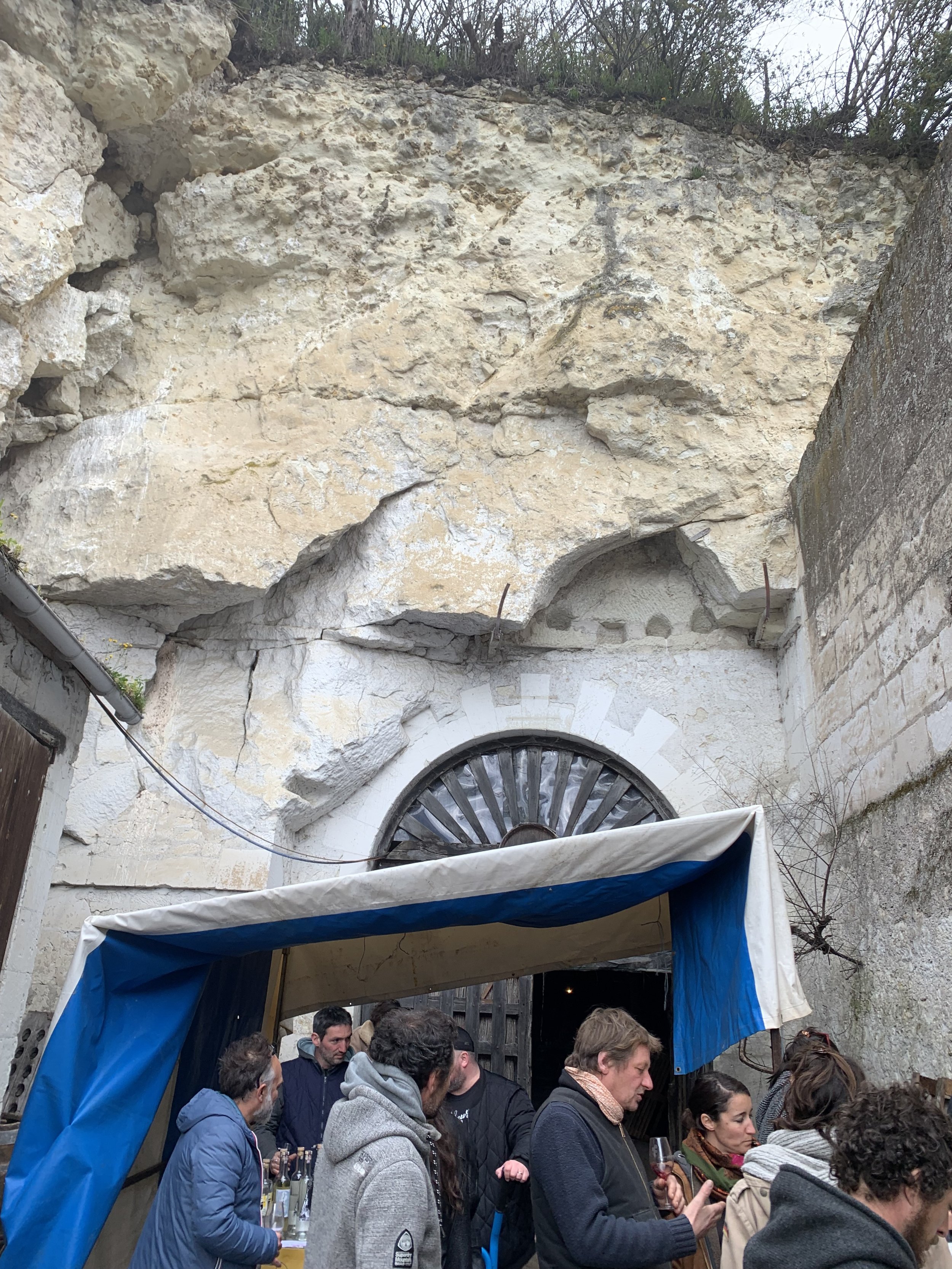Partying in a cave with Paul Gillet from Maisons Brûlées.
I attended my third 10-year anniversary party in the month of March. Whether you are a winemaker, a pizza maker, or a wine importer, a decade in business is a mile marker worthy of some cake and balloons.
Finding this sign on the small roads of France was no small task.
I left Paris and drove to Vineuil. Paul Gillet was hosting a soirée. At least a dozen natural vignerons were pouring wine in a limestone cave. Can’t miss that! The entrance to the fête was in the cliff that faced a tertiary road. It felt like I had ventured deep into the Loire. Townsfolk weren’t privy to this happening. I found it because of a short line of cars. The vehicles looked busted enough to belong on farms. Dead giveaway.
Driving to Vineuil, I was surrounded by farmland bright green with the arrival of spring. I’m breaking the news: Touraine is pretty in March. It just is. I passed pheasants ambling along a narrow road. I’m not old enough to care about bird stuff, but their plumage was colorful. Almost metallic. There were signs for chèvre fermier attached to stone barns. Streams bisected clusters of ancient houses. Occasional stands of short, knotted vines made pointillist designs on barely sloped fields. I traversed abundant woodland presumably filled with game.
Outside Paul’s party it was 10 degrees Celsius and barely raining. I was greeted by a disgruntled dog, and a raucous cluster of wine people. “Nobody has arrived for a while, so they are happy you are here.” A nice woman from Le Petit Domaine in Montpeyroux was the first to offer a wine sample. It was a Chenin, a surprise to me, since her winery is in the Languedoc. It was pleasant: round, soft orchard fruit aromas.
Merguez sausages were for sale at the cave’s entrance. Five euros, same price as a tasting glass. A barrel of vine cuttings was being turned into coals for fuel. A young red-haired woman stood behind a folding table turned sandwich station. Having alerted participants to the danger of an American in their midst, the black and white shepherd mutt slunk back to an alcove filled with aromas of grilling meat and improvised ashtrays.
I showed up for the second half of the second day of a two-day event, a celebration that clearly had continued late into the previous evening. You’ve showed up late and witnessed the last embers of a gathering: you know what I mean. Some participants were low-grade buzzed, not so much hyped up, more slouched back. There were more louche commentators than participants. I hadn’t been to France in nearly four years. To me, the prevailing languorousness accentuated the Frenchiness of the proceedings. Small clusters of cellar workers were holding onto last scraps of energy. Buoyed by nicotine, caffeine, and steady sips of sprits, they fought the headwinds of hangovers. Tasting continued. Conversation became animated.
Determined to keep festivities in motion, I said hello to Paul. He seemed jovial, dented but unbroken. Pressing on to the finish line. He invited me to dinner. Kind. I’d return to Paris to eat fantastic grilled leeks and monkfish in the 9th, but the invitation was generous, and appreciated.
I passed the barrel top covered in spirits, and approached the cave’s entrance. It was intimidating. A Tolkien moment. Pure darkness. Cold air flowed out. In the middle distance I could discern a string of Christmas lights. It was losing the battle against blackness. This would be a different kind of blind tasting! As my eyes adjusted, I latched onto the first discernible form. Another barrel, and a man. From Amsterdam!
Bert Mol was an importer of natural wine based in the Netherlands, who made a career change in 2016. His biodynamic vineyards are on the banks of the Cher river, near Thésée. I meandered through this village two days later. Sleepy. Goats, chickens, stone walls. Anyway, Bert poured a really nice Touraine Sauvignon from the 2021 vintage, followed by a skin-contact white (also Sauvignon) that had been hand-pressed and aged in barrel for 18 months. Mol’s eight hectares of vines were hit pretty hard by hail last year, so the 2022 Pinot d’Aunis we tasted was produced from purchased grapes grown in the Vendome. It smelled of pomegranate, and also a little meaty/bloody. I’d like to try it again one day.
In the back of the cave, Caroline and Alexandre Bain were holding court. They seemed unaffected by the long days of work. Articulate. Focused. Alexandre’s wines are well known in NC, and relatively widely available. I was happy to get reacquainted with Bain's lineup. The 2019 Pierre Precieuse is made from Bain’s 11 hectares of biodynamically farmed Sauvignon Blanc. Wild yeast, 10mg/l of sulfur. It smelled distinctly of orange rind. The wine is really excellent. Its complex citrus and mineral palate is undimmed by 39 months of aging in wood and concrete. Next up was the 2018 L. D’Ange, a wine that Bain said had spent two years in wood barrel, and two years in bottle. Again, the wine was quite good, more bruised apple than citrus, but pleasantly so. Finally, we tasted the 2019 Chant Couturier, a wine made from overripe fruit picked from vines in the northern part of the Pouilly-Fume AOC. Alexandre recommended it be served with spicy food, which makes sense.
Bain’s wines really stood out.
Paul Gillet’s Poussiere de Lune blanc was hanging out on an empty barrel stand close to the Bains, so I grabbed a splash. Gauzy golden apple aromas. Faintly yeasty. It is Sauvignon and Menu Pineau grown in a well-regarded site called Le Herdeleau, close to their home village of Pouillé.
It’s hard to be the host. Entertaining, organizing, keeping the fires burning. By 5pm, the rustle of winemakers moving unopened cases towards their Renaults was palpable. I tasted with a half dozen additional farmers, as energy waves carried us inexorably toward the light rain and soft chalk facade of the entrance. Hit me up if you want more natural wine tasting notes from the loveable fringe of the thriving natural wine community in France. I’ll share my mostly filled, well-traveled, beat-to-shite notebook with you. Eventually I bid farewells, told a winemaker or two that I’d drop by their caves (more about that in future missives) and plotted a route to the capital. It’s hard to drive fast through this landscape. Bucolic. Charming AF. Oh la la.
Now my car smells of Selles sur Cher cheese. There are worse things. The kids disagree.




